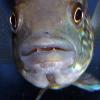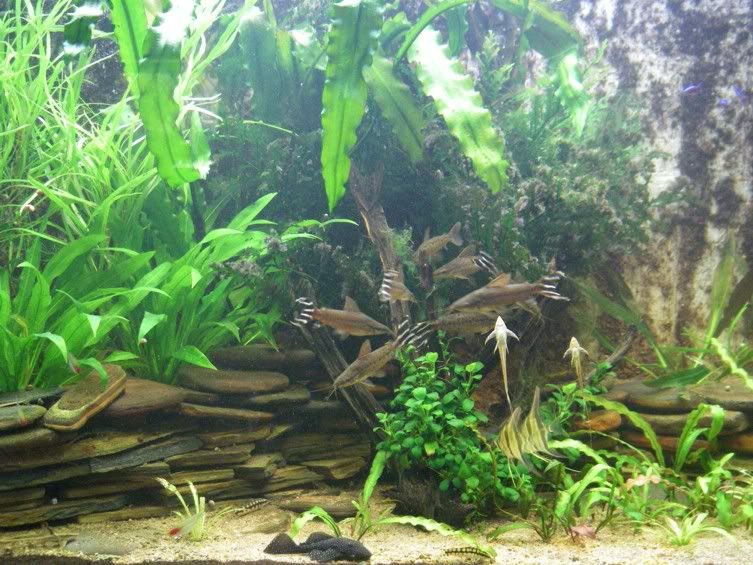In the late 80's I managed to get a trio of these fish in Brisi. I bought them as adults and have been a huge fan fan of these fish ever since. I'd kept them for about two months when they surprised me with a batch of eggs, on the front glass pane to boot – talk about excited.
That was the peek of excitement because from then and untill recently the part that follows was very trying and as many have also learned, typically ends up with complete loss of the fry and less frequently just a hand full of babies. My best success then, was about 12-15 babies and using a very time consuming method of blanched zucchini peals stuck to the side of a naked tank, just, filter, heater and air stones to generate current. The zucchini peals go off quickly and need to be switched with fresh ones as soon as they start to disintegrate. Similar approaches still seem to be used a lot, but these days I can not afford to devote that much attention to these fish as I am regularly away from Perth for up to a week at a time.
Just over a year ago I settled in Perth and got a tank as soon as I could - A group of royals followed as soon as I could get some good quality fish. These have been regularly spawning for me for about 6 months now. I've been able to get the timing right one previous spawn of which I have 8 juves that are just becoming sexable now ~7cm.
So I've been working towards an automated solution that can be left without any attendance for a week or longer. What I describe here is my progress to date as lately I've had some very incouraging results. But this is still a work in progress and the goal is to rear 70-80% of a clutch
Spawning These Fish: The Easy Part
Sexing adult fish is pretty easy: Males develop pronounced bristles (odontodes) on their 'cheeks', they possess more strongly hooked dorsal and pectoral fins and are generally more solid in the body than females. See images below.
Adult Pair, Female on Left

Adult Pair Male Above

Head of Male Close Showing 'Cheek' Bristles (odontodes)

Getting these fish to spawn is not hard – just condition the females with lots of good greens or algae wafers and they will take care of the rest. They do like to spawn in currents and I've had a male take up position on an Aponogeton leaf about 10 cm away from a power head outlet. Males fan and care over the eggs over ~ 7 days depending on the water temperature. As the embryos develop the eggs get progressively darker and finally hatch as fairly well formed fry. At that point on the Male completely disregards his brood and they scatter through the tank.
NOTE: If the eggs are disturbed after ~ day 5, you can easily trigger a mas premature hatching. This does not seem to worry the embryos much – they simply cling to something and continue their development untill their yolk is absorbed; however, it is an issue if this happens in a community tank....
If you want to move a clutch from the community tank to a rearing tank and the brood is on a leaf, cut it away from the plant and scoop the leaf out with an ice-cream container – if the leaf is lifted out of the water, expect most of the fry to start hatching. When the leaf is transferred into the fry tank, there is also a high chance that they will all hatch ... even after careful equilibration of the water. Similarly if you try and scrape the eggs from the glass after day 5, they are also likely to hatch prematurely. I use a safety razor and a siphon hose to catch the eggs and babies as soon as they come free from the glass.
This premature hatching is a real surprise when this happens the first time, but its not a show stopper.
The adults will spawn frequently if the food supply is kept up and the female can be in spawning condition again in 2 weeks.
Rearing The Young: The Hard Part:
As most will know who have tried rearing these fish: from free-swimmers to 3 cm is really tough. Most resources on the net recommend methods requiring allot of attention: daily water changes, fresh food changes daily, and scrupulous hygene .... one can still easily loose the lot in no time and it is usual to get a dozen or less through to adults.
The main issue resulting in the high mortality is getting food into the fry. These fry simply will not seek out food in their early stages. To understand why, and to also trouble shoot this issue, you need to know that these are riverine species and they like a bit of current in the water – doubly so for the newly hatched fry.
The rocks and driftwood surfaces from any river with moderate to high flow rates, especially in the shallows, are all covered with a growth of algae and other micro organisms. This living film also called aufwuchs [surface growth] represents the primary food for most small - medium Loricariids, and importantly is likely to be the first food for all fish in this family. Aufwuchs naturally exists on every solid surface in their native home; so all the fry need to do is rasp away (they have well developed sucker mouths), and they get food. There is no need for these guys to actively seek out food and they don't … and in aquariums they starve to death because aufwuchs is typically absent.
All methods of rearing these fish rely on resolving this challenge: getting food into a fish that will not seek out food …
I am aware of several methods that attempt to address this issue and I don't claim the one described here as the only solution – but it is the only one I know of that you can leave completely alone for a week or more and come home to a tank of baby royals. After they get past the 3 cm mark they have usually started to seek out the food and can be trained onto quarter split algae wafers. Losses after this point are significantly less.
Set-Up:
- Rearing (and spawning) tank is 60 x 30 x 30 cm;
- appropriate sized heater (if in winter);
- 1 foot standard fluorescent light;
- tank covers – the adult are likely to be flighty after being transferred and are disappointingly good at jumping out ...

- one sponge filter with a Resun submersible power head. These power heads come with a double outlet, at 45° to each other and this is the one I use.
- one Eheim auto-feeder (rotating barrel type)
The idea is to create a moderate turbulent current, not a laminar current in the tank. The fry food is powdered algae wafers and I want this food 'dust' to spread throughout the tank. A laminar current from a single outlet tends to concentrate food in areas – usually IN the sponge filter … not where I (or the babies) want it ... The surface of the water needs to be moving everywhere, but not boiling. The fish will be very happy in a 'boiling' current; however, that food will not settle and it will all eventually end up in the filter...
Next thing is increasing feeding surface area. I want lots of surfaces in the water column for the food to settle onto or get caught on, but not enough to impede the current much. The tank is currently furnished with a few bunches of Willow leaf Hygrophila and several flat stones (bits of slate in this case) set into a sand bottom, at 30-45° off horizontal.
An Eheim auto-feeder (rotating barrel type) is used set on the following feeding times:5:00 Double delivery; 10:00, 15:00, 22:00 latter 3 all single feeds: the feeding slot is set at ~ 3mm gap. I use Algae wafers that I grind into dust using a spice/coffee grinder – grind until I no longer hear the clinking of bits of algae wafer (~ 1 minute).
The tank needs to be well established with a stable nitrogen cycle. My rearing tank is always set up and all I did was switch out the airs tone on the sponge filter and fit the power head. The only other occupants at the time were about a dozen or so ram-horn snails and some Aponogeton crispus (I think) pups - now in outdoor tubs.
The conditioned adults were added shortly after filter modification, and they spawned 3 days later. After the fry hatched, the adults were carefully caught out and returned back into the main tank.
The automated feeder was set up as described above and 5 days later I was in the field for 6 days. On return, all was well and babies were all full bellied. I am writing this a week later (3 and a half weeks after hatching). Losses appear to me minimal. It' s hard to keep track of numbers given the presence of the plants and stones, but I'd guess there to be about 30-40 in there. The female never seems to produce large clutches of eggs, usually 50-60.
Side view of rearing tank

End on view of rearing tank

As of this afternoon they are ~15 mm long

I made a number of tweaks with this system and this is the first time I've integrated an auto-feeder. Previously I tried to establish self sustaining aufwuchs but this is really hard to do.
So far the results with the autofeeder are promising. I'll be leaving this lot alone and see how many get over the 3 cm mark.
I noted above that this is the current iteration in an evolving project and would love to hear possible ways of further refinements
Cheers E.
PS Photos are not the best and I was pushing the macro on my phone camera today.




 Find content
Find content



